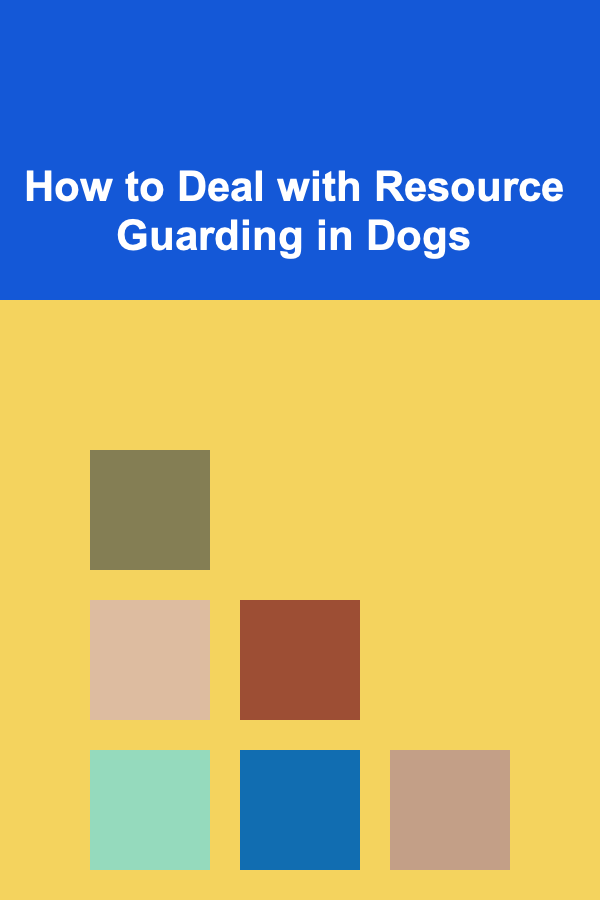
How to Deal with Resource Guarding in Dogs
ebook include PDF & Audio bundle (Micro Guide)
$12.99$6.99
Limited Time Offer! Order within the next:

Resource guarding is a common behavior in dogs that occurs when they perceive certain objects, spaces, or even people as valuable and attempt to protect or defend them from perceived threats. These resources may include food, toys, favorite resting spots, or even human attention. While resource guarding can manifest in various degrees, from mild to severe, it is essential to understand the behavior and address it appropriately. In this article, we will explore the underlying causes of resource guarding in dogs, how to identify its signs, and, most importantly, how to effectively manage and modify this behavior through training and positive reinforcement.
Understanding Resource Guarding
Resource guarding is instinctual behavior rooted in the dog's need for survival and safety. In the wild, animals often compete for limited resources, and guarding behavior is a natural response to protect valuable assets. For domesticated dogs, however, these instincts can be triggered in environments where resources are abundant, but the dog's need to guard them becomes a problem when it leads to aggression or anxiety.
Resource guarding may be directed at various types of resources. While food is the most common, dogs may also guard:
- Toys: Dogs may guard their toys, preventing other dogs or even humans from taking them.
- Space: Some dogs exhibit guarding behavior over specific areas like their bed, crate, or favorite spot in the house.
- People: Dogs may also display resource guarding behavior over human attention, becoming possessive of their owners.
Recognizing that resource guarding is a normal, albeit undesirable, behavior is the first step toward addressing it. It is crucial to distinguish between minor possessiveness and more severe aggression that can lead to conflicts, injury, or distress.
The Causes of Resource Guarding
While resource guarding is often an innate behavior, there are several factors that may trigger or exacerbate this response in dogs. Understanding the root causes of this behavior is essential for addressing it effectively.
1. Genetics and Breed Tendencies
Certain breeds have a higher predisposition for guarding behavior due to their genetic makeup and history of working as protectors. Breeds like the Rottweiler, German Shepherd, Doberman Pinscher, and Bull Terrier are often more prone to resource guarding because of their protective instincts. However, it is essential to recognize that any dog, regardless of breed, can exhibit resource guarding behaviors.
2. Fear or Anxiety
Resource guarding is often a sign of fear or anxiety. A dog may guard food, toys, or other resources as a way of coping with feelings of insecurity or vulnerability. If a dog has experienced trauma, neglect, or lack of proper care, it may become possessive of resources as a way of ensuring its survival.
3. Scarcity of Resources
In multi-dog households or homes where resources like food and toys are limited, dogs may begin to guard these items out of fear of not getting enough. Dogs who have not been socialized properly or those who have had negative experiences in the past may feel that they must defend their possessions to ensure they are not deprived.
4. Lack of Socialization
Puppies who are not properly socialized may develop resource guarding behaviors as they grow older. During the critical early socialization period, which typically occurs between 3 and 14 weeks of age, dogs learn how to interact with humans and other dogs. Without exposure to a variety of situations, people, and other animals, a dog may become more protective of its resources as it perceives others as threats.
5. Reinforcement of Guarding Behavior
In some cases, resource guarding may be inadvertently reinforced by the dog's owner. For example, if a dog growls or snaps when a human or another dog approaches its food bowl, and the owner then backs off or gives the dog more space, the dog learns that guarding its resources will result in getting what it wants. This cycle can strengthen the behavior over time.
Identifying the Signs of Resource Guarding
Before addressing resource guarding, it is important to recognize the signs. Resource guarding can vary in intensity, and early intervention is key to preventing more serious issues from developing.
1. Growling or Snapping
A dog that is guarding a resource may growl, snap, or bark when approached by another dog or person. This is a clear sign that the dog feels threatened and is trying to protect the item in question.
2. Stiff Body Language
When a dog is guarding a resource, it may display stiff or tense body language. The dog may freeze or become rigid when someone approaches its resource. This is a sign of heightened alertness and protective behavior.
3. Resource Positioning
A dog that is resource guarding may position itself in a way that blocks access to the resource. For example, it might stand in front of its food bowl, curl its body around a toy, or lie on top of its bed to prevent others from getting close.
4. Baring Teeth
In more severe cases of resource guarding, a dog may bare its teeth or show other signs of aggression when its resources are threatened. This behavior indicates a higher level of threat perception and a stronger instinct to protect the resource.
5. Avoiding Eye Contact or Moving Away
On the flip side, some dogs may display more passive signs of resource guarding, such as avoiding eye contact or backing away when someone approaches their resources. This can indicate that the dog is anxious about losing control over the item but may not immediately show aggression.
How to Deal with Resource Guarding in Dogs
Dealing with resource guarding requires patience, consistency, and positive reinforcement. Punishing the dog for guarding behavior is ineffective and can make the problem worse. Instead, the goal is to teach the dog that resources are not something to be feared or protected aggressively. Here are several strategies for managing and modifying resource guarding behavior:
1. Identify Triggers and Avoid Confrontation
The first step in addressing resource guarding is identifying the specific triggers that cause the behavior. Pay attention to the times, places, and objects that cause the dog to guard. Is it the food bowl? A specific toy? A favorite bed? Once you have identified the triggers, try to avoid putting your dog in situations where it feels the need to guard its resources.
For example, if a dog guards its food, it is essential to feed it in a quiet, low-stress environment without the presence of other pets or distractions. Avoid approaching the dog during meals until it is comfortable and relaxed.
2. Teach the "Leave It" and "Drop It" Commands
Training your dog with basic obedience commands such as "leave it" and "drop it" is one of the most effective ways to manage resource guarding. These commands teach the dog that giving up an item does not lead to negative consequences and that relinquishing control of a resource can result in a reward.
To teach "leave it":
- Hold a treat in your hand and allow the dog to sniff it.
- Close your hand around the treat and say "leave it."
- Wait for the dog to stop trying to get the treat, and once it does, reward with praise and a different treat.
To teach "drop it":
- Place a toy or item in the dog's mouth.
- Say "drop it" and offer a treat or another toy as a trade.
- When the dog drops the item, reward immediately.
Over time, the dog will learn that giving up a resource leads to something positive.
3. Positive Reinforcement
Use positive reinforcement to reward your dog for calm behavior around resources. If your dog remains relaxed while you approach its food bowl, toy, or bed, reward it with treats or praise. This helps the dog associate the presence of others with positive outcomes, making it less likely to feel the need to guard.
4. Gradual Desensitization
Gradual desensitization involves slowly getting the dog accustomed to the presence of others near its resources without triggering aggressive behavior. Start by approaching the dog from a distance while it is engaged with a resource and rewarding calm behavior. Gradually decrease the distance over time, always rewarding the dog for relaxed behavior.
It is important to move at the dog's pace during this process, as rushing can cause the dog to become anxious or defensive.
5. Resource Control
In cases where resource guarding is severe or persistent, it may be necessary to manage the environment by controlling access to resources. For example, use baby gates or crates to separate dogs during meals or when they have access to toys. This allows the dog to enjoy its resources without feeling threatened or territorial.
6. Professional Help
If resource guarding is severe or if the behavior escalates into aggression, seeking help from a professional dog trainer or behaviorist is highly recommended. A trainer with experience in resource guarding can provide personalized guidance and techniques tailored to your dog's specific needs.
Conclusion
Resource guarding is a natural behavior in dogs, but it can become problematic when it leads to aggression, anxiety, or conflict. Understanding the causes of resource guarding and recognizing the signs of this behavior are crucial in addressing it effectively. Through positive reinforcement, proper training, and patience, most dogs can learn to overcome resource guarding behavior and develop healthier, more secure relationships with their resources and their human companions.

How to Create a Farmhouse Look Without Spending a Lot of Money
Read More
How to Create a Well-Lit Reading Nook in Your Home
Read More
How to Declutter Your Dining Room Before Hosting Guests
Read More
How to Reduce Turnover Rates in Your Rental Property
Read More
How To Understand Different Narrative Points of View
Read More
How to Learn a Language Through Culinary Arts
Read MoreOther Products

How to Create a Farmhouse Look Without Spending a Lot of Money
Read More
How to Create a Well-Lit Reading Nook in Your Home
Read More
How to Declutter Your Dining Room Before Hosting Guests
Read More
How to Reduce Turnover Rates in Your Rental Property
Read More
How To Understand Different Narrative Points of View
Read More